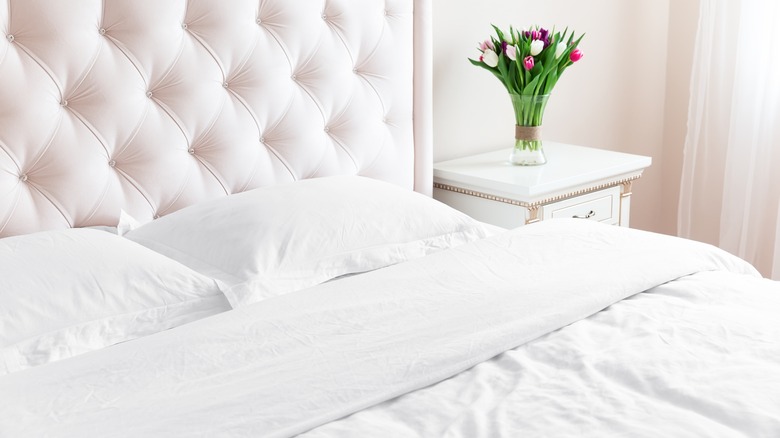The One Type Of Bedding Nate Berkus Can't Stand
Interior designer Nate Berkus is accustomed to sharing all kinds of tips and tricks about home design, from measures the average individual can implement to level up their own space to customized suggestions he makes on the design shows he appears on alongside husband Jeremiah Brent.
In terms of his bedding preferences, though, the one thing he can't stand has absolutely nothing to do with aesthetics and everything to do with practicality. As Berkus told Homes & Gardens in an interview, "I don't like bedding that sleeps warm — I don't know many people that do."
Instead, his recommendation is to find bedding that "sleeps a little cooler" because it offers more options. It's similar to the logic that you can always add on additional layers of clothing while dressing on a chilly day, whereas it's a lot harder to get comfortable when it's insanely hot outside because you reach a limit of the layers you can shed. In bedding terms, it's always possible to layer on extra blankets if you need a little more warmth, whereas if your bedding is trapping all your body heat and leaving you waking up in a sweat every night, there's not much you can do.
The answer is to make a few swaps in your bedding. While you can always take measures to cool the interior of your home in general, in terms of creating a bed that sleeps a little cooler, as per Berkus's preference, there are a few key things to consider.
Go-to factors for bed sheets that sleep cool
In a super hot climate, you might not even bother with a duvet or comforter. Or, if you live somewhere where the temperature varies a lot throughout the year, you might decide to store your thicker bedding for the cooler season and keep things a bit simpler during the hotter months. Either way, one of the few non-negotiables for any bedding set is the sheets. You need them to cover your mattress below you, and a top sheet can even serve as a great light blanket alternative for truly hot weather.
However, not all sheets are created equal when it comes to keeping things cool — there are a few factors to keep an eye on.
First, while you might assume that a higher thread count is automatically better, that isn't the case if keeping cool is your top priority. That's because a higher thread count means your sheets are woven more tightly, and thus aren't quite as breathable. Aim for a thread count between about 180 and 280. Additionally, opt for a percale weave over a sateen weave, again because the former allows for a bit more airflow, helping keep things cool.
In terms of the material, natural fibers like cotton and bamboo lead the pack, with man-made Tencel serving as another great choice. All three fabrics are known to be good at absorbing moisture and very breathable, making them solid picks for those who sleep a little hotter.
Other components of your bedding to tweak
If swapping out your sheets just isn't enough, don't worry — there are a few more components of your bedding that can be tweaked to help try to cool things down.
First of all, don't ignore your pillows. While larger pillows might feel cozy, they can actually trap heat. Consider swapping one larger pillow with two more compact options, or even seek out pillows that have some type of cooling gel within, or a breathable cover.
A cooling mattress topper can also be a great addition for temperature regulation (as well as a little boost of extra comfort, as any mattress topper delivers).
And, if you just can't sleep properly without a cozy duvet, you'll also want to consider which one you're using year-round (if you live in a climate that gets both very hot and very cold, you may need more than one option for optimal sleep). Just like with sheets, select duvets and comforters that are crafted from materials that wick moisture and allow for air to circulate, such as cotton and bamboo, and that contain natural fillings like down or wool rather than synthetic fillings, which can trap in the heat and moisture your body is putting off.
Finally, don't forget to factor in the tog rating, which is an indicator of just how warm a duvet is. The lower the rating, the more lightweight the duvet, so choose something on the lower end of the scale.


